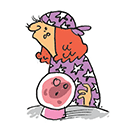Taking the Kids: Celebrating the new year Bahamian style
When the kids tire of their holiday gifts and start whining that they've got nothing to do, just hand them some holiday wrapping paper, crepe paper, cardboard, glue and some wire.
Challenge them to create a costume. That's what thousands of Bahamians do every year for the Junkanoo Festivals and parades held on Boxing Day (the day after Christmas) and on New Year's Day across the Bahamian Islands (www.bahamas.com).
These costumes are amazing -- meticulously put together with thousands and thousands of strips of brightly colored crepe paper adorned with feathers and gold and silver buttons -- gold and orange, bright blue and pink, green and purple.
They transform the wearer into a tropical fish, a butterfly, a traditional "Beefeater" you'd see guarding the Tower of London, a bird or even a character from "Transformers" or "Sesame Street."
In Nassau where there is also a junior Junkanoo Festival in which local schools compete and parade, even preschoolers take part.
"They just have to hear one drumbeat and you have their full attention," said Arlene Nash Ferguson, the Nassau grandmother who has made it her mission to get young Bahamians to participate, founding the Educulture Bahamas Junkanoo Mini-Museum and Resource Centre (www.educulturebahamas.com) in Nassau, her childhood home, (www.nassauparadiseisland.com).
Nash Ferguson, a veteran educator, has been involved in Junkanoo festivals since she was a preschooler and she continues to work hard to promote native Bahamian culture to everyone. What she began with programs for school kids in the Bahamas in 2000 now attracts cruise ship passengers and other visitors for workshops in Junkanoo costume making where you might make a headdress or a wall hanging to take home.
The music, she explains, is still centered on cowbells, which were available on plantations, and the goatskin drum, an African instrument. The traditional Junkanoo horn was a conch shell; today, there are a variety of other horns and whistles used as well.
Some hotels are also getting into the act. The Grand Lucayan Resort (www.grandlucayan.com) on Grand Bahama Island, for example, has its own Junkanoo band that performs for guests in their costumes all year round, as well as during the holidays when there is also a Santa's Nature Walk, among other activities. We literally walked into the weekly Junkanoo parade while there!
Junkanoo festivals began during the 16th and 17th centuries when slaves in the Bahamas were given a special holiday around Christmas and could leave the plantations. They'd celebrate with African dance, music and costumes. The slaves decorated themselves with materials they could find -- straw, sponge, plants. The costumes have always been crafted from whatever was available, even newspapers.
Nash Ferguson said using those newspapers might have been "passive resistance" on the slaves' part, as they were forbidden from learning to read or write. She has those historic costumes in the museum, some made of used rags, as well as more recent ones. One year, Nash Ferguson went dressed as a hailstorm in baby blue and white.
Young Bahamians, she said, earn thousands of dollars gluing the paper onto the intricate costumes, some as tall as 15 feet, some weighing 80 pounds.
Groups work on the costumes, the dancing and the music all year, working in "shacks" around the island that might be simple backyard cottages.
No matter what the temperature, the marchers wear these heavy, hot costumes for hours. The parade starts at 2 a.m. and lasts into midday the next day. "We're still dancing at midday," Nash Ferguson said. "It just captivates you every year."
And as soon as one festival is done, the group -- that may include hundreds of people -- start working on their theme and their costume design for the next year with entire families involved.
Families, of course, are central to Bahamian life and culture. Longtime local Romeo Farrington says it's important for tourists to see more than Nassau's famous Straw Market or Atlantis' waterslides. "Too many people never leave the resort while they are here," he says.
They are missing a lot, including the chance to be hosted by locals via the People-To-People experience that is completely free. The Abaco Beach Resort has taken the concept a step further, enlisting local kids to join young hotel guests for supervised activities that stress Bahamian culture. (Read what I wrote about it here, http://www.takingthekids.com/weekly-column/visiting-kids-should-not-leave-the-bahamas-without-meeting-the-local-kids/.)
Bahamians always want to share their culture with visitors, says Nash Ferguson, and visitors should join the fun, she says.
"We have a fabulous time telling stories with the costumes, the dance and the music," she said.
Besides, "You can tell a story and reinvent yourself each year." And what can be better than that.
========
Check out the latest in Eileen's series of Kids City Guides to LA and Chicago, available from major booksellers and online. For more Taking the Kids, visit www.takingthekids.com and also follow "taking the kids" on www.twitter.com, where Eileen Ogintz welcomes your questions and comments.
(c) 2013 DISTRIBUTED BY TRIBUNE MEDIA SERVICES, INC.










Comments